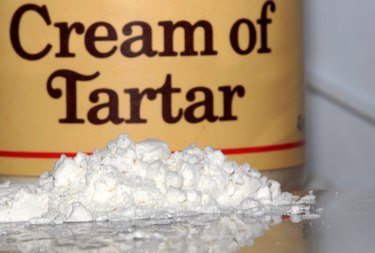Cleaning the oven isn't typically an easy or pleasant job. Self-cleaning ovens generate lots of smoke and heat when you use that cycle, and the spray-on cleaners are bad-smelling and hard on your skin. Putting down an oven liner to catch drips will help speed the process in future, but there are also lots of simple hacks to make oven cleaning easier right now.
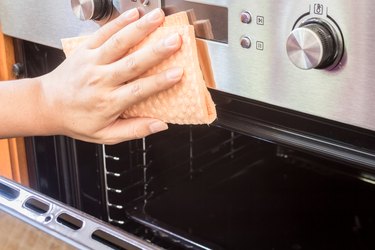
Video of the Day
1. Brush Out Debris First
The very first thing to do, before you start splashing around with cleansers, is simply to clean out any loose, dry debris. This eases the process in two ways. First, dry "gunk" is easier to get out of the oven than the same gunk once it's wet and sticky. Second, removing that layer makes it easier for your cleansers of choice to penetrate. Use a nylon scraper or wooden spoon to scrape and loosen the debris (metal might scratch the oven's surface) and then use a brush, whisk broom, dry cloth or even your vacuum to remove as much of it as possible.
Video of the Day
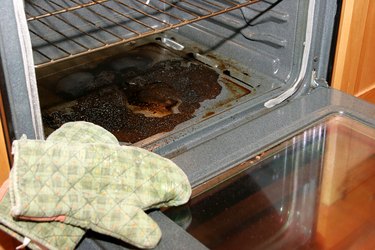
2. Do Some "Steam Cleaning"
One key to easier oven cleaning is simply to avoid scrubbing. One very simple and environmentally sound method is to bring a wide, shallow pot or pan of water to a boil, and then place it in your oven. Block the spot (usually under a burner) where hot air vents from the oven, to keep the steam in, and wait for at least an hour. At that point, remove the pot of hot water and take the racks from your oven. Most of the soil on the ceiling and walls and bottom of your oven will be softened and loosened, and should wipe right off with a wet and soapy cloth. Repeat as needed.

3. Add Acidity to the Steam
While steam alone can work wonders in your oven, a lot of the stuck on soil in your oven is fat-based and therefore doesn't respond well to water-only treatments. You can double down on its cleaning power by adding some grease-cutting acidity o the water you put in the oven. Make sure there's excellent ventilation — vinegar is pungent — and that the oven's vent is plugged. The steam will carry the vinegar to the oven's walls as it condenses, where it'll help loosen fatty deposits and make them easier to clean away.
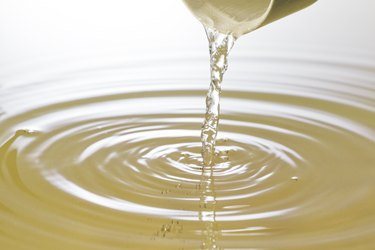
4. Use Baking Soda and Vinegar
After steaming and wiping down your oven, you'll be left with the stuff that's seriously stuck on. At this point, it's time to dial things up a notch and use a DIY cleaner that will do some active scrubbing for you. Make a paste of baking soda and water, and scrub it lightly into the areas where tough stains have built up. Next, mix up a spray bottle of vinegar and water. Spray that liberally onto the paste-covered areas, close the door, and wait. As the soda and vinegar react, they'll foam vigorously and work to loosen and lift the soil. Wipe away with a clean cloth, and repeat if necessary.

5. Scrub With a Toothbrush
Getting into the cracks and crevices of your oven is best attempted with a brush, but not just any brush will do. The bristles should be fine enough to get into the cracks, but stiff enough to scrape out the gunk. Ideally a handle with some flex would help you apply pressure, as well. A plain ol' toothbrush fits the bill quite adequately, but don't stop there. An inexpensive electric toothbrush with a rotating head is even better, and it's much easier than trying to scrub really hard at the very back your your oven.

6. Remove the Oven Door
There are times when there's no help for it, you're just going to have to get into that oven and scrub. When you do, you'll find it infinitely easier if you take the door off. On most home ranges, the hinges are designed to stop once the door is open a few inches. At that point, you can simply lift it off its hinges in most cases, though some doors may have a hinge lock you'll need to remove first. With the door off, you'll easily be able to reach the oven's ceiling and back walls, and hey...that oven door will be a lot easier to scrub when it's sitting flat on a table or countertop.

7. Give the Racks a Bath
While you're scrubbing out the oven itself, don't neglect the opportunity to give the racks a good cleaning. Unless you have an oversized dishwasher, the most convenient place to do that is your bathtub. Place a towel in the bottom of the tub to protect its finish from the steel racks, then add a mixture of baking soda and vinegar (or a splash of dish soap) and enough hot water to cover them. Let them soak while you finish with the oven, then wipe them down with a clean cloth and a non-abrasive scrubber. Once you've finished, give them a quick rinse in fresh water before putting them back in the oven.
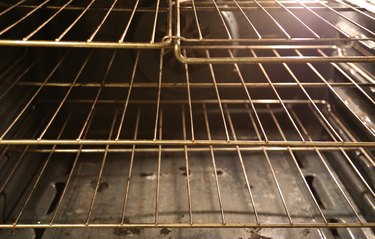
8. Use a Dishwasher Tablet
The tablets you use in your dishwasher have unusually powerful cleansers and grease-cutters in them, because they can't count on conventional scrubbing and physical contact to get the dishes clean. That makes them useful for stubborn soil on your oven and its door. The simplest way to use one is to moisten one end, and use it as an "eraser" for stubbornly sticky stains. You can also crush one and dissolve it in a cup or two of hot water, then use this to wash down the interior. Wear gloves if you wash by hand, because there's a chance the concentrated cleanser may irritate your skin.
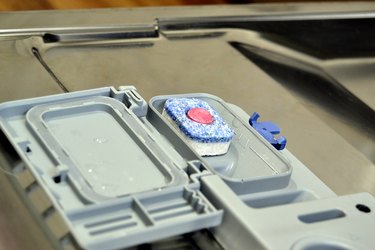
9. Bring On the Power Tools
You may not know this, but some unsung genius of the power-tool industry recognized that the right attachments could turn a standard cordless drill into a powered, elbow-saving super scrubber. You'll find the brush attachments online, if your local hardware store doesn't carry them. Their only drawback is that the brush will spatter soapy water everywhere, so use eye protection. In a similar vein, you can attach a scouring pad to a palm sander and use that to attack the very last, most stubborn soil.
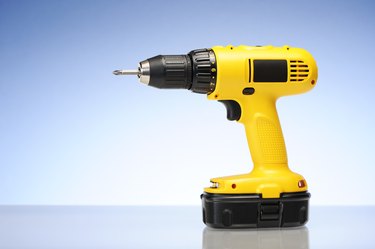
10. Tartar For the Final Cleaning
The last step in cleaning your oven is often just getting rid of the greasy residue left by your cleaning efforts. Vinegar works, but it's not exactly pleasant to smell. A better option is cream of tartar, an ingredient bakers often have on hand. The fine crystals are both acidic — therefore, good at cutting grease — and a fine abrasive, making them doubly effective. Shake some of the crystals onto a damp cloth and use them to give your oven a final scrub, then rinse with clean water to leave it sparkling.
